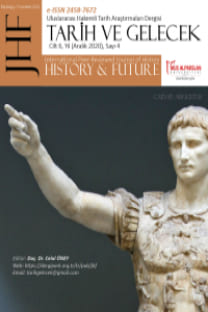Sevakin: Osmanlı İmparatorluğu’nda Kuzeydoğu Afrika Limanı
Sudan, Sevakin Adası, Habeş Eyaleti, Afrika, Osmanlı İmparatorluğu
Suakin: A Northeast African Port in the Ottoman Empire
Suakin Island, Sudan, Province of Abyssinian, Africa, Ottoman Emprie,
___
- ‘Awaḍ ‘Abd al-Hādī al-‘Atā, “Sawākin wa-Maṣṣawa‘ fī ‘ahd al-ḥukm al-Turkī al-Miṣrī,” in Ta’rīkh al-Dawla al-‘Uthmāniyya: Malāmiḥ min al-‘alāqāt al-Sūdāniyya al-Turkiyya, ed. Yūsuf Faḍl Ḥasan, Jāmi‘at al-Khartūm, Khartoum 2004.
- Baybars al-Manṣūrī, Zubdat al-Fikra fi Ta’rīkh al-Hijra, ed. D. S. Richards, Das Arabische Buch, Beirut and Berlin, 1998.
- ÁLVARES, Francisco, The Prester John of the Indies, trans. Lord Stanley Hakluyt Society, Cambridge, 1961.
- BACQUE-GRAMMONT J. L. and Anne Krœll, Mamlouks, Ottomans et Portugais en Mer Rouge: L’affaire de Djedda en 1517, IFAO, Cairo 1988.
- BARKAN, Ömer Lutfi,“H.933–934 (M. 1527–1528) Mali Yılına Ait Bir Bütçe Örneği,” İstanbul Üniversitesi İktisat Fakültesi Mecmuası, Sayı: 15,1953.
- BEĞ, Feridun, Münşeat ül-Selatin, Tophane-i Amire, İstanbul, 1274/1855.
- BRUCE, James, Travels to Discover the Source of the Nile, Edinburgh: J. Ruthven, 1790.
- BRUCKHARDT, J. L., Travels in Nubia, John Murray, London, 1822.
- CRAWFORD, O. G. S., The Fung Kingdom of Sennar, Gloucester, UK: John Bellows, 1951.
- COATES, T. J., “João de Castro’s 1541 Red Sea Voyage in the Greater Context of the Sixteenth Century,” in Decision Making and Change in the Ottoman Empire, ed. Caesar E. Farah Kirksville, Thomas Jefferson University Press, 1993.
- GOITEIN, S. D. Goitein and Mordechai A. Friedman, “India Traders of the Middle Ages: Documents from the Cairo Geniza:” India Book, Part 1, Brill, Leiden, 2008
- S. D. Goitein, “New Light on the Beginnings of the Kārimi Merchants,” Journal of the Economic and Social History of the Orient 1, no. 2 (1958), 178.
- Ethiopian Itineraries ca. 1400–1524, ed. O.G.S Crawford, Hakluyt Society, Cambridge, 1958.
- Evliya Çelebi, Seyahatnamesi, 10: Kitap, ed. S. A. Kahraman, Y. Dağlı, and R. Dankoff, Yapı Kredi Yayınları, Istanbul, 2007.
- HASAN, Yūsuf Faḍl, The Arabs and the Sudan, Edinburgh University Press, Edinburgh 1967.
- HOFHEİNZ, Albrecht , “Sawākin,” Encyclopedia of Islam, Brill, Leiden,1997.
- __________________; “Transcending the Madhhab—in Practice: The Case of the Sudanese Muhammad Majdhūb (1795/6–1831),” Islamic Law and Society, 10 no. 2 2003.
- Ibn Baṭṭūṭa, The Travels of Ibn Baṭṭūṭa, trans. H. A. R. Gibb, Hakluyt Society, London, 1956.
- KAMMERER, Albert, Le routier de Dom Joam de Castro: L’exploration de la Mer Rouge par les Portugais en 1541, P. Geuthner, Paris, 1936.
- MALLİNSON, Michael et al., “Ottoman Suakin, 1541–1865: Lost and Found,” in The Frontiers of the Ottoman World, ed. A. C. S. Peacock Oxford University Press, London, 2002.
- Naîmâ Mustafa Efendi, Târîh-i Na‘îmâ, ed. Mehmet İpşirli, Türk Tarih Kurumu, Ankara 2007.
- ORHONLU, Cengiz, Osmanlı İmparatorluğu’nun Güney Siyaseti: Habeş Eyaleti Istanbul Üniversitesi Edebiyat Fakültesi, İstanbul, 1974.
- PEACOCK, David and Andrew Peacock, “The Enigma of ‘Aydhab: A Medieval Islamic Port on the Red Sea Coast,” International Journal of Nautical Archaeology , 37, no. 1, 2008.
- SANCEAU, E., “Uma narrativa da expedição portuguesa de 1541 ao Mar Roxo,” Studia 9, 1962.
- SERJEANT, R. B., The Portuguese off the South Arabian Coast, Oxford University Press, London, 1974.
- Shihāb al-Dīn Aḥmad b. al-Wahhāb al-Nuwayrī, Nihāyat al-Arab fī Funūn al- Adab, ed. M. Qumayḥa and I. Shams al-Dīn, Dār al-Kutub al-‘Ilmiyya, Beirut, 2004.
- Silahdar Mehmed Ağa, Silahdar Tarihi, Devlet Matbaası, Istanbul, 1928.
- Abdurrahman Abdi Paşa, Vekâyi‘- Namesi (Osmanlı Tarihi [1648–1682]), ed. Fahri Ç. Derin, Istanbul, 2008.
- SPAULDING, Jay and Muhammad Ibrāhīm Abū Salīm, Public Documents from Sinnār, Michigan State University Press, East Lansing, 1989.
- Suma Oriental of Tomé Pires: An Account of the East, from the Red Sea to China, Written in Malacca and India in 1512–1515 and the Book of Francisco Rodrigues, Pilot Major of the Armada That Discovered Banda and the Moluccas, Hakluyt Society, Armanda Cortesao, ed. and trans., London, 1944.
- The Red Sea and Adjacent Countries at the Close of the Seventeenth Century, William Foster, ed., Hakluyt Society, London, 1949.
- The Itinerary of Jerónimo Lobo, trans. Donald M. Lockhart Hakluyt Society, London, 1984.
- TIBBETS, Cf. G. R. Tibbets, “Arab Navigation in the Red Sea,” Geographical Journal, 127, no. 3, 1961.
- Topkapı Sarayı Arşivi H. 951–952 Tarihli ve E-12321 Numaralı Mühimme Defteri, Halil Sahilloğlu, ed., IRCICA, Istanbul 2002. O’FAHEY, R. S. and J. L. Spaulding, Kingdoms of the Sudan Methuen, London, 1974.
- ÖZBARAN, Salih Özbaran, “An Ottoman Report on the Red Sea and the Portuguese in the Indian Ocean (1525),” in The Ottoman Response to European Expansion: Studies on OttomanPortuguese Relations in the Indian Ocean and Ottoman Administration in the Arab Lands during the Sixteenth Century, Isis, Istanbul, 1994.
- Quṭb al-Dīn al-Nahrawālī, al-Barq al-Yamānī fī 1-Fatḥ al-‘Uthmānī, ed. Ḥamad Jāsir Dār al-Yamāma, Riyadh 1967.
- Yayın Aralığı: Yılda 4 Sayı
- Başlangıç: 2015
- Yayıncı: Celal ÖNEY
Osmanlı Donanması’nın Tatlı Su İhtiyacının Karşılanması
Akşehir Ayânı Hacı Paşazâde Ahmet Bey’in Terekesi
27 Mayıs Askeri Darbesinin Vilayetlerdeki Yansımaları: Bitlis Örneği
Akademik Araştırma, Organize Olma Ve Yazma Süreçlerinde Zotero
Sovyet Kazakistan’ında Eğitimin Genel Durumu (1930-1940)
Emeviler Döneminde Fars Bölgesi ve Şiraz Şehri
XI.-XII. Yüzyıllarda Zencan’da Bir Türkmen Beyliği: Kafşutoğulları
19. yüzyılda Yabancı Büyükelçi ve Misyonerlerin Osmanlı İmparatorluğu Yönetimiyle İlişkileri
Yunan Panteonuna Luvi Etkisi: Pegasos Örneği
